Onward Tamil Soldiers! Pirapāharan’s Inspiration remains Potent
Posted on December 21st, 2015
Michael Roberts, courtesy of Colombo Telegraph, 19 December 2015, where it appears under a different title.
Note that the images deployed here are not found in the CT version, where the Bibliography is also less expansive. Do also attend to the reasons why I have expanded the Bibliography: viz., a desire to elaborate the concept of sacrificial devotion” ……. ……. =http://sacrificialdevotionnetwork.wordpress.com/ … a tool used extensively in my studies of Tamil Tiger devotion to cause and suicide attacks plus defensive suicide on capture as one facet of this commitment.
Way back in the 1960s the scholar Sinnappah Arasaratnam noted that in Sri Lanka two (communal) extremisms were feeding off each other and thereby sharpening conflict (1967, 1974 & 1979). This was, of course, just one factor contributing to a developing crisis that requires a careful analysis that identifies the multiple factors aggravating division. The tragic tale remains true today: Sinhalese and Tamil extremists continue to stir the pot and gain vigour by attacking each other (and others too).
The vehemence is all the greater because the vanguard of such fervour resides among migrants in Western lands who are encouraged by the freedom of the internet to ride the waves of communication with slander and sarcasm as their principal weapons. Among the Sri Lankan Tamils of the diaspora, of course, this venom has been grounded in the bitter experiences that induced so many to leave Sri Lanka in the last three decades of the 20th century.
Via familial stories as well as the vast propaganda machinery built up by the LTTE over the last 25 years this fervour has been transmitted to some of the second/third generation migrants brought up in these lands. As with so many Tamils living in Sri Lanka in the 1990s and 2000s Velupillai Pirapāharan, thetalaivar of Thamilīlam, was more or less a deity among these migrant peoples. In fact, he was likened to a Sun God (Jeyaraj 2009).
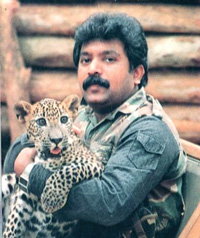 Figs 1 & 2
Figs 1 & 2  Pirapāharan in his early days as freedom fighter … Fig 3
Pirapāharan in his early days as freedom fighter … Fig 3 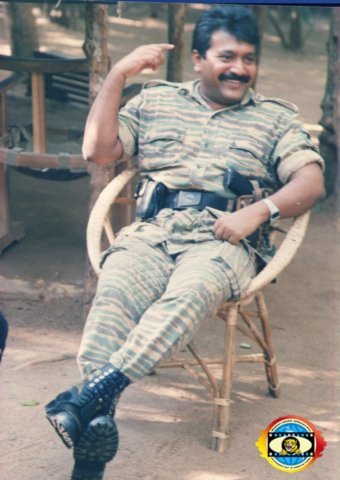
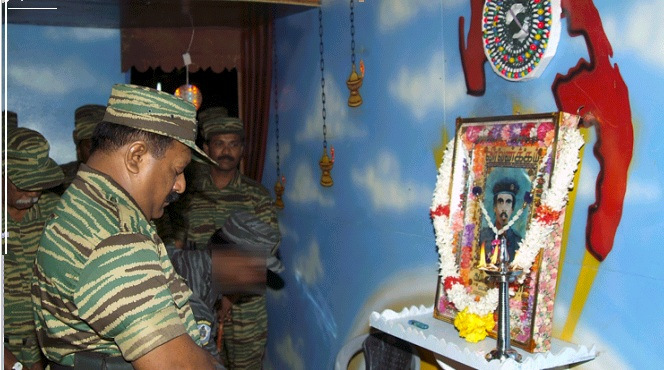 Fig 3–Pirapāharan pays homage to Black Tigers on 5th July 2005, with garlanded image of Miller, the first Black Tiger suicide bomber, as principal symbol — Pic from TamilNet. Note that Miller’s target on 5 July 1987was a SL Army compound at Nelliyadi and cannot in any way be considered an act of terrorism”
Fig 3–Pirapāharan pays homage to Black Tigers on 5th July 2005, with garlanded image of Miller, the first Black Tiger suicide bomber, as principal symbol — Pic from TamilNet. Note that Miller’s target on 5 July 1987was a SL Army compound at Nelliyadi and cannot in any way be considered an act of terrorism”
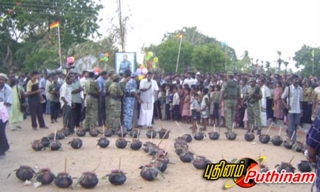 Fig 5 = Fifty pongal for the talaivar on his 50th birthday — 26 November 2004
Fig 5 = Fifty pongal for the talaivar on his 50th birthday — 26 November 2004
 Fig 6= Kopay tuyilam illam readied for Māvīrar Nāl, 2004
Fig 6= Kopay tuyilam illam readied for Māvīrar Nāl, 2004
 Fig 7 = A Māvīrar Nālgathering in Germany, 2004… with displays of the heroes on the walls of a hall
Fig 7 = A Māvīrar Nālgathering in Germany, 2004… with displays of the heroes on the walls of a hall 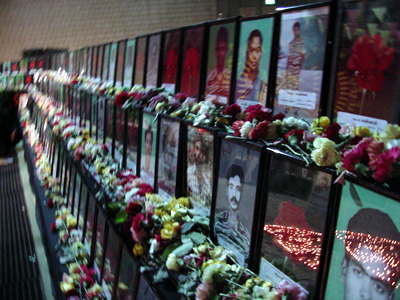 Fig 8
Fig 8
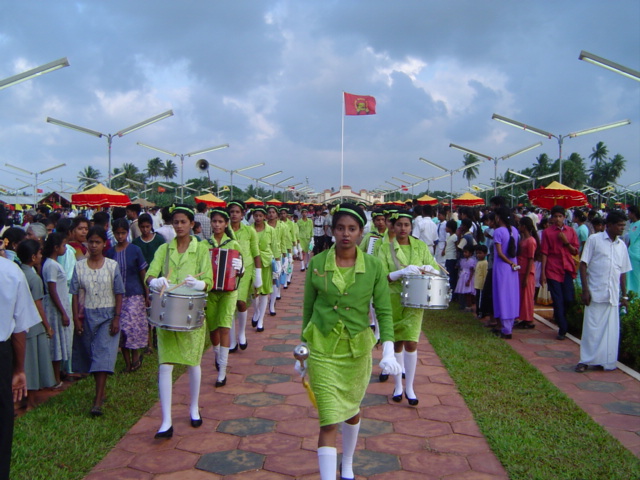 Fig 9 & 10= Māvīrar Nāl pageantry & gathering, 2004
Fig 9 & 10= Māvīrar Nāl pageantry & gathering, 2004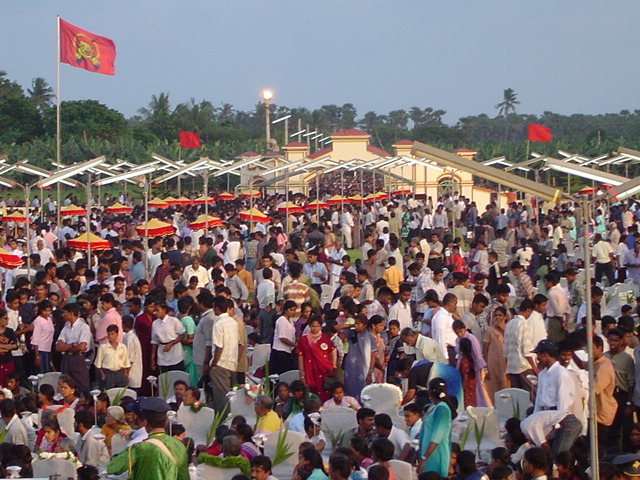 Fig 10
Fig 10
During the halcyon days of the LTTE this worship was expressed on his birthday 26th November[1] – a day that happened to precede an even more important moment of Tamil Tiger bonding, Māvīrar Nāl celebrated every 27th November to pay homage to the Tiger dead and re-affirm the peoples’ commitment to the goal of Eelam (Schalk 2003; Roberts 2009; Natali 2008… and Figs. 6-10).
The demise of Pirapāharan on 18th May 2009 has not dented this worship of the Sun God or the commitment to the liberation struggle among many Tamils in the island and abroad. The 18th May has now been added to the ritual calendar of Thamilīlam as Genocide Day,” with protest events being organized by the faithful in many cities in the West.
 Fig 11 = Offerings to Pirapāharan on 26th November 2012 – Pic from a Tamil pal, with no further details [see Roberts, Tamil Person and State. Pictorial, p. 207 for elaboration]
Fig 11 = Offerings to Pirapāharan on 26th November 2012 – Pic from a Tamil pal, with no further details [see Roberts, Tamil Person and State. Pictorial, p. 207 for elaboration]
Likewise, conventional Saivite ceremonies of goodwill and sustenance for Pirapāharan are still conducted in some places in Sri Lanka and abroad to bestow blessings on his life’s journey on 26th November every year (see Fig. 11). A large Tamil gathering at Wembley in London to mark Pirapāharan’s greatness by commemorating his birthday (captured on camera by a Sinhalese migrant: Fig. 12) recently raised a minor storm among Sinhalese of an internet communication chain, adding to the fuel planted by the success of the Sri Lankan Tamil networks in persuading USA, the West and the UN bureaucracy to press war crimes charges against the government of Sri Lanka.
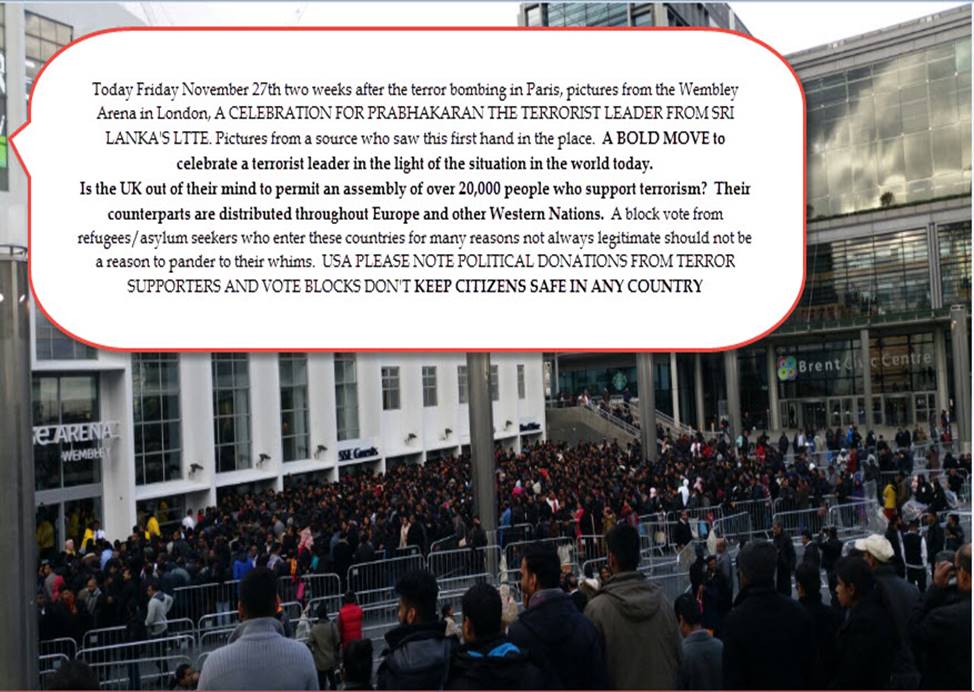 Fig 12 = SL Tamils gatherat Wembley … arouse Sinhala agitation
Fig 12 = SL Tamils gatherat Wembley … arouse Sinhala agitation
However, it is the commemoration of Heroes’ Day on the 27h November every year in many cities and towns in the West that marks the commitment of Sri Lankan Tamils (and other supporters) to the cause of an independent Tamil state of Thamililam. These gatherings in 2015 were not confined to London and Toronto, but seem to have been mounted in numerous cities – for instance from Fribourg in Switzerland to Oslo in Norway. Such moments of coordinated activity must surely sustain the fervour displayed on the streets of so many cities in the West in March-April-May 2009 as the LTTE slid to comprehensive military defeat (Figs 13, 14 & 15).
 Fig 13= SL Tamils assemble for Māvīrar Nāl in Oslo, 2015 ….and (Figs 14 & 15)
Fig 13= SL Tamils assemble for Māvīrar Nāl in Oslo, 2015 ….and (Figs 14 & 15) 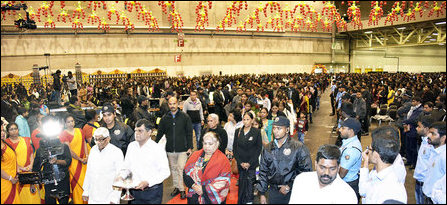
 in Fribourg, Switzerland, with typical Tamil drama performances rooted in past time, albeit with an LTTE flavour, to inspire the audience
in Fribourg, Switzerland, with typical Tamil drama performances rooted in past time, albeit with an LTTE flavour, to inspire the audience  Fig 16
Fig 16
In the course of researches into the last stages of the war through studies of the Wikileaks exposure of the US ambassador’s dispatches to Washington, I perceived a chance process which may have contributed to the success of Tamil agitation in penetrating official US thinking in 2009. In my surmise, logically, similar processes could be occurring now as we speak. My write-up was placed in the Colombo Telegraph on the 9th December 2015. As expected, it drew the ire of the many piranhas (in this instance SL Tamil) who inhabit the air waves.
However, one of these sniper attacks by one Thanga” on the 11th December 2015 was, as Neville Jayaweera intimated, carefully crafted and quite clever. Thanga challenges my characterization of the LTTE as fascist” and insists that the LTTE was a party of freedom fighters and therefore remains popular among Tamils unlike Hitler and Mussolini in their countries. The LTTE was immensely popular with the masses. …. the armed struggle was a direct result of state violence inflicted on Thamils ever since independence. Chandrika Kumaratunga put it succinctly when she said Prabhakaran is the product of Sinhala racism. One cannot create a fighting force from thin air. Concrete socio-political-economic conditions must exist.”
Thanga’s neat sound-bites and part-truths do not a comprehensive argument make. He is guilty of gross oversimplification. It is entirely feasible for a freedom fighter movement to be fascist in structure and organizational form. The dead bodies of so many Tamil parliamentariansgunned down by the Tigers and the heaps of TELO and EPRLF dead are grotesque testimony to Pirapāharan’s killer mentality (Hoole 2001).[2] As a reporter for the Economist indicated, Pirapāharan was a textbook fascist who went on to murder his Tamil rivals, inspire love and terror among his followers and monopolise the Tamil nationalist cause.”[3]
Alas, this did not dim his popularity both within Thamilīlam and in some drawing rooms in Colombo and in many drawing rooms of the diaspora. On this count I do not question Thanga. Pirapāharan remains venerated today.
But Thanga also requires a little history lesson. With Hitler and Mussolini after 1944/45, the German and Italian peoples had no choice: occupying armies sat astride their countries for decades; while the Allies, quite intelligently, deployed the Marshall Plan to rebuild Germany and Europe in ways which have enabled Germany today to become the headmistress of the European Union. The US Army had contingents at strategic sites in West Germany, including Heidelberg when I resided there for spells in 1976 and 1987.
But it is with reference to Sri Lankan history in the period 1948 to 1983 that Thanga requires a history caning. Part-truths do not a story make, the more so when — as I indicated at the outset – a complex configuration of forces sharpened the pre-existing ethnic divide to a point of bitter conflict.
The ethnic (also called communal”) differentiation between Sinhalese and SL Tamils in Sri Lanka has been long-standing and grounded in cultural practices as much as political history. What sharpened the divisions in the independence era was the process of democratic politics from 1948-1970 within (A) a particular political structure and (B) the island’s peculiar demographic configuration (Roberts 1978; Wilson 1975).
Point A refers to the Westminster system of parliamentary elections based on first-past-the post electoral constituencies set up (in good faith but with disastrous results) by the Soulbury Constitution. Given the specific distribution of ethnic groups in the island, the political parties discovered over the decade 1956-1960s that a small swing in votes led to a landslide victory for either the SLFP or the UNP. Robert Kearney’s studies reveal this aspect quite clearly (1967 & 1973).[4] There was a structural disincentive for anyone to promote compromise politics across the ethnic divide (Roberts 1978). That is why the main Leftist parties abandoned their principled support for parity of status for both languages” and joined Mrs. Bandaranaike’s alliance in 1964. In blaming the demagogy of her father and mother (plus the UNP) Chandrika Bandaranaike is oversimplifying. The failures were system induced.
Yes, Sinhala prejudices, the political demagogues and the work of prejudiced bureaucrats after the Sinhala Only Act was in place also contributed to the polarization. However, Sinhala politicians were not the only demagogues (as Neville Jayaweera has clarified in his biography — 2014). The Tamil politicians were not without their prejudices and also indulged in demagogic activity. The Tamil intelligentsia also practiced considerable dissimulation by proposing that the whole of the Eastern Province was part of their traditional homelands.” As early as the 19th December 1949 this specific dishonesty was embedded in the manifesto of the Federal Freedom Party of the Tamil-speaking People of Ceylon” (ITAK 1949). This particular Tamil argument can be interpreted as a maximization claim of the sort seen in the history of Japanese and German fascism too – a form of lebensraum” that forcibly embraced the Sri Lankan Muslims as Tamil.
I do not expect Thanga to take kindly to this brief history lesson. My schoolmaster tones will him repel. Besides, he is hardcore Tiger and venerates Pirapāharan. In brief, he is probably incorrigible. That fact is a pointer to the vast network of support and tutelage to the memory of Pirapāharan and his Tigers that exists among the Sri Lankan Tamil peoples all over the world today. This is the most significant contention that I leave for readers to ponder. In such a milieu, the positions of moderate Tamils like David Jeyaraj and Rajan Hoole will, as Thanga affirms, carry little weight among the Tamil masses. Democratic politics trumps sensibility and produces, well, Trumps – Donald Trumps of the Sri Lankan Tamil variety.
*** ***
APPENDIX https://www.tamilnet.com/art.html?catid=13&artid=38027
Occupied Tamil Eelam marks Heroes Day amidst ‘Sri Lankan’ harassment
[TamilNet, Friday, 27 November 2015, 13:54 GMT] Tamil Eelam Heroes Day was observed in the occupied country of Eezham Tamils amidst intensified monitoring by the occupying military intelligence operatives of genocidal Sri Lanka on Friday. The university community in Jaffna, comprising the student union, teachers association and the union of non-academic staff gathered at Parameasvarar temple, which is located inside the campus of the University of Jaffna, to mark the largest event after 2009 to be organized braving the intimidating presence of the SL military intelligence operatives. Earlier in the day, former TNA parliamentarian and Northern Provincial Councillor M.K. Shivajilingam lit the flame of sacrifice at the historic Nalloor temple. A special prayer was held at St. Patricks Church in Jaffna.
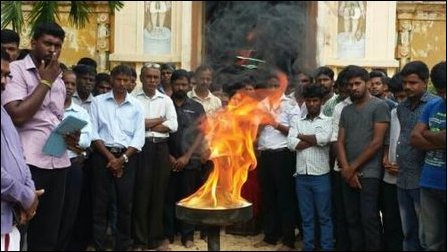 Flame of Sacrifice at Nallur Temple
Flame of Sacrifice at Nallur Temple
Pirapāharan pays homage to maaveerar on an earlier occasion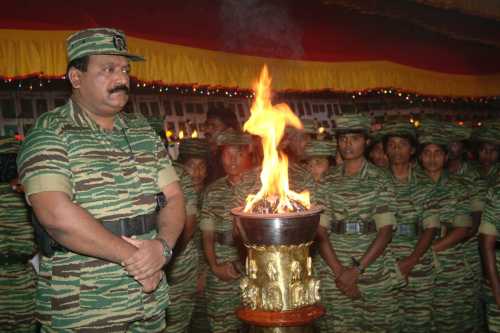
EXTENDED BIBLIOGRAPHY … where I take the liberty of including a wide range of references to inform readers of the type of material one has to take into account. Believe you me, this list is only a tithe of the books and articles I have had to read over years of teaching and research — especially with reference to the topic of sacrificial devotion”, the concept I deploy to embrace the commitment to cause reveled by the Tamil Tigers, the kamikaze and modern-day jihadists…in implicit challenge to the oversimplified use of the term terrorism.”
Those interested in the manner in which practices of what one can call enchantment” occurred together with hard-headed practical skills in the military and assassination operations of the LTTE, I recommend a dip into the works by Bastin, Kailsapathy, Mines, Mosse, Nagarajan, Nabokov, Siemen-Netto and Tanaka. There are many other pertinent readings, but these will do for a start.
Aiyappan, A. 1977. Deified Men and Humanized Gods: Some Folk Bases of Hindu Theology.” in The New Wind: Changing Identities in South Asia, ed. Kenneth David. Hague: Mouton Publishers, pp. 95–104
Arasaratnam, Sinnappah 1967 Nationalism, Communalism and National Unity in Ceylon,” in Philip Mason (ed.) India and Ceylon. Unity and Diversity, OUP, pp. 260-78.
Arasaratnam, Sinnappah 1974 History, Nationalism and Nation Building: The Asian Dilemma, Inaugural Lecture at the University of New England, Armidale.
Arasaratnam, Sinnappah 1979 Nationalism in Sri Lanka and the Tamils,” in M. Roberts (ed.) Collective Identities, Nationalisms and Protest in Modern Sri Lanka, Colombo: Marga, pp. 500-19.
Bastin, Rohan. 2002a. The Domain of Constant Excess: Plural Worship at the Munnesvaram Temples in Sri Lanka. New York: Berghahn Books.
Bastin, Rohan 2002b. Sorcerous Technologies and Religious Innovation in Sri Lanka.” Social Analysis 46, no. 3: 154–174.
Chalk, Peter 1999. The Liberation Tigers of Tamil Eelam’s (LTTE) International Organization and Operations: A Preliminary Analysis.”Commentary 77 (Winter). http://www. cis-scrs.gc.ca/en/publications/commentary/com77.asp.
Chandrakanthan, A. J. V. 2000. Eelam Tamil Nationalism: An Inside View.” Pp. 157–175 inSri Lankan Tamil Nationalism: Its Origins and Development in the Nineteenth and TwentiethCenturies, ed. A. Jeyaratnam Wilson. London: Hurst and Company.
Daniel, E Valentine 1989 ‘Three dispositions towards the past: one Sinhala, two Tamil’, Social Analysis 25: 22-41.
Dharmadasa, K N O 1992 Language, religion, and ethnic assertiveness in Sri Lanka, Ann Arbor: University of Michigan Press.
De Silva, K M 1981 A history of Sri Lanka, Delhi: Oxford University Press.
De Silva, K M 1986 Managing ethnic tensions in multi-ethnic societies. Sri Lanka, 1880-1895, Lanham, New York: University Press of America.
Economist 2010 Victory for the Tiger Slayer,” 28 January 2010,http://www.economist.com/node/15393468
Farmer, B H 1964 ‘The social basis of nationalism in Ceylon’, Journal of Asian Studies 24: 431-39.
Harman, William 2011. Embracing the Martyred Dead: The Tuyilam Illam as SacredShrines for the Sri Lankan Tamil Tigers.” Paper presented at the conference of the American Academy of Religion at San Francisco, November.
Hellmann-Rajanayagam, Dagmar 1994 The Tamil Tigers: Armed Struggle for Identity. Stuttgart:Franz Steiner Verlag.
Hellmann-Rajanayagam, Dagmar 2005. ‘And Heroes Die’: Poetry of the Tamil Liberation Movement in Northern Sri Lanka.” South Asia 28, no. 1: 112–153.
Hoole, Rajan 2001 The Arrogance of Power. Myths, Decadence, Murder,Nugegoda: Wasala Publications for the UTHR
ITAK 1949 Inaugural Meeting of the Ilankai Tamil Arasu Kadchi, Colombo, 18December 1949… with Presidential Address by SJV Chelvanayakam,” in M. Roberts, Tamil Person and State. Pictorial, Colombo: Vijitha Yapa Publications, pp. 273-92.
Jayaweera, Neville 2014 Jaffna: Exorcising the Past and Holding the Vision
Jeyaraj, DBS 2009 Prabhakaran: Powerful symbol of Tamil armed struggle,”http://dbsjeyaraj.com/dbsj/archives/650
Kailasapathy, K. 1968. Tamil Heroic Poetry. Oxford: Clarendon Press.
Kearney, Robert N. 1967 Communalism and language in the politics of Ceylon, Durham, N C: Duke University Press.
Kearney, Robert N. 1973 The Politics of Ceylon (Sri Lanka), Ithaca.
Kemper, Steven 1991 The presence of the past. Chronicles, politics, and culture in Sinhala life, Ithaca: Cornell University Press.
Manikkalingam, Ram 1995 Tigerism, Colombo: a pamphlet.
Manogaran C and Bryan Pfaffenberger 1994 The Sri Lankan Tamils. Ethnicity and identity, Boulder: Westview Press.
Mines, Diane P. 2005. Fierce Gods: Inequality, Ritual, and the Politics of Dignity in aSouth Indian Village. Bloomington: Indiana University Press.
Mosse, David. 1994. Catholic Saints and the Hindu Village Pantheon in Rural TamilNadu, India.” Man (n.s.) 29, no. 2: 301–332.
Narayan Swamy, M R 1994 Tigers of Lanka. From boys to guerillas, Delhi: Konark Publishers Pvt.
Nabokov, Isabelle 2000. Religion against the Self: An Ethnography of Tamil Rituals. Oxford: Oxford University Press.
Nagarajan, Vijaya R. 2007. Threshold Designs, Forehead Dots, and Menstruation Rituals: Exploring Time and Space in Tamil Kolams.” Pp. 85–105 in Women’s Lives, Women’s Rituals in the Hindu Tradition, ed. Tracy Pintchman. Oxford: Oxford University Press.
Natali, Cristiana 2008 Building Cemeteries, Constructing Identities: Funerary Practices and Nationalist Discourse among the Tamil Tigers of Sri Lanka.” Contemporary South Asia 16, no. 3: 287–301.
O’Duffy, Brendan 2007 LTTE: Majoritarianism, Self-Determination, and Military-to-Political Transition in Sri Lanka.” Pp. 257–287 in Terror, Insurgency, and the State:Ending Protracted Conflicts, ed. Marianne Heiberg, Brendan O’Leary, and John Tirman.Philadelphia: University of Pennsylvania Press.
O’Duffy, Brendan 2003 Self Determination and Conflict Regulation in Sri Lanka, Northern Ireland and beyond,” 8 May 2003,http://tamilnation.co/selfdetermination/tamileelam/0305duffy.htm
Peiris, Gerald H. 2013 An Appraisal of the Concept of a Traditional Tamil Homeland in Sri Lanka,” 26 April 21013, https://thuppahi.wordpress.com/2013/04/26/an-appraisal-of-the-concept-of-a-traditional-tamil-homeland-n-sri-lanka/
Pfaffenberger, Bryan 1979. The Kataragama Pilgrimage: Hindu-Buddhist Interaction and Its Significance in Sri Lanka’s Polyethnic Social System.” Journal of Asian Studies 38, no. 2: 253–270.
Pratap, Anita 2001. Island of Blood: Frontline Reports from Sri Lanka, Afghanistan and
Other South Asian Flashpoints. New Delhi: Viking.
Roberts, Michael 1978 Ethnic Conflict in Sri Lanka and Sinhalese Perspectives: Barriers to Accommodation”, Modern Asian Studies, 12:353-76.
Roberts, Michael 2001a Ethnicity after Said: post-Orientalist failures in comprehending the Kandyan period of Sri Lankan history,” Ethnic Studies Report 19: 69-98.
Roberts, Michael 2001b Sinhala-ness and Sinhala nationalism,” Colombo: Marga Monograph Series on A History of Ethnic Conflict in Sri Lanka:Recollection, Reinterpretation and Reconciliation, Colombo: Marga Monograph Series, No 4.
Roberts, Michael 2002a Primordialist strands in contemporary Sinhala nationalism in Sri Lanka: urumaya as Ur,” Colombo: Marga Monograph Series on A History of Ethnic Conflict in Sri Lanka Recollection, Reinterpretation and Reconciliation, Colombo: Marga Monograph Series, No 20.
Roberts, Michael 2002b Modernist theory. The printed word. The instance of pre-modern Sinhala
society, Colombo: ICES Monograph Series.
Roberts, Michael 2003a The Agony and Ecstasy of a Pogrom: Southern Lanka, July 1983,” Nethra
special issue, 6: 199-213.
Roberts, Michael 2003b Language and National Identity: The Sinhalese and Others over the Centuries,” Nationalism and Ethnic Politics 9: 75-102.Roberts, Michael 2005 Saivite Symbolism, Sacrifice and Tamil Tiger Rites”, Social Analysis 49: 67-93.
Roberts, Michael 2006 Pragmatic Action & Enchanted Worlds: A Black Tiger Rite Of Commemoration,” Social Analysis 50: 73-102.Roberts, Michael 2007 Suicide Missions as Witnessing: Expansions, Contrasts,” Studies in Conflict & Terrorism 30, no. 10: 857–887.
Roberts, Michael 2008 Tamil Tigers: Sacrificial Symbolism and ‘Dead Body Politics.’”Anthropology Today 24, no. 3: 22–23.
Roberts, Michael 2010 Killing Rajiv Gandhi: Dhanu’s Sacrificial Metamorphosis in Death?” South Asian History and Culture 1, no. 1: 25–41.
Roberts, Michael 2010 Ethnic Identity in Sri Lanka’s Pre-Capitalist Past: Shanie, Darshanie and Roberts,” 15 August 2010,https://thuppahi.wordpress.com/2010/08/15/ethnic-identity-in-sri-lanka%E2%80%99s-pre-capitalist-past-shanie-darshanie-and-roberts/
Roberts, Michael 2011 Death and Eternal Life: Contrasting Sensibilities in the Face of Corpses,” 29 June 2011,https://thuppahi.wordpress.com/2011/06/29/death-and-eternal-life-contrasting-sensibilities-in-the-face-of-corpses/
Roberts, Michael 2012 Velupillai Pirapaharan: VEERA MARANAM.” Thuppahi’s Blog,26 November.https://thuppahi.wordpress.com/2012/11/26/velupillai-pirapaharan-veera-maranam.
Rogers, John D. 1994 Post-Orientalism and the interpretation of pre-modern and modern political identities: the case of Sri Lanka,” Journal of Asian Studies53: 10-23.
Rogers, John D. 2004 Early British rule and social classification in Lanka,”Modern Asian Studies 38: 625-47.
Schalk, Peter. 1997. Resistance and Martyrdom in the Process of State Formation ofTamililam.” Pp. 61–84 in Martyrdom and Political Resistance: Essays from Asia andEurope, ed. Joyce Pettigrew. Amsterdam: VU University Press.
Schalk, Peter. 2003. Beyond Hindu Festivals: The Celebration of Great Heroes’ Day by the Liberation Tigers of Tamil Eelam (LTTE) in Europe.” Pp. 391–411 in Tempel und Tamilien in zweiter Heimat, ed. Martin Baumann, Brigitte Luchesi, and Annette Wilke. Wurzburg: Ergon Verlag.
Siemon-Netto, Uwe 2002. A Goddess and Lucky Numbers Are Allies in Sri Lanka War: TheTamil Tigers’ Elusive Leader Is a Devotee of the Hindu Goddess Kali, but Not the Figure 8.” United Press, 12 August.
Taraki [D. P. Sivaram] 2004a. LTTE Develops Asymmetric Deterrence to Stall Foreign Intervention.” Daily Mirror, 22 May.
Taraki 2004b. Strategic Positioning Vital for Military Advantage.” Daily Mirror, 21 July.
Taraki 2005a. What Is the Larger Picture in Pirapakaran’s Mind?” Daily Mirror, 9 March.
Taraki 2005b. Are Tigers Militarily Weak?” Daily Mirror, 23 March.
Spencer, Jonathan (ed.) 1990a Sri Lanka. History and the roots of conflict, London: Routledge.
Spencer, Jonathan 1990b A Sinhala village in a time of trouble, Delhi: Oxford University Press.
Wickremeratne, Ananda 2006 Historiography in conflict and violence,” in M. Deegalle (ed.) Buddhism, conflict and violence in modern Sri Lanka, London: Routldge, pp.114-33.
Wilson, AJ 1975 Electoral Politics in an Emergent State: The Ceylon General Elections of May 1970, CUP.
*** ***
FOOTNOTES & CITATIONS
[1] I have seen photographs of ceremonies involving pandals or a circle of pots in his honour held in places in Thamililam and the north of Sri Lanka during the 1990s and 2000s but will need to search for them.Figure 5 is one illustration.
[2] Also see the following sources:
- http://www.defence.lk/new.asp?fname=Tamil_Politicians_Priests_Public_Officials_and_Academics_killed_by_the_LTTE_20131103_01
- https://en.wikipedia.org/wiki/List_of_assassinations_of_the_Sri_Lankan_Civil_War
[3] See ‘Victory for the Tiger Slayer,” 28 January 2010,http://www.economist.com/node/15393468
[4] I benefited from personal interaction with Kearney during his visits to Sri Lanka where on one or two occasions he presented a paper before the Ceylon Studies Seminar at Peradeniya. This seminar series and personal interaction with such personnel as AJ Wilson. KM de Silva, Shelton Kodikara, Gerald Peiris and other colleagues at Peradeniya helped me sharpen my analytical skills… and provided the grounding for my arguments in Ethnic Conflict in Sri Lanka & Sinhalese Perspectives: Barriers to Accommodation,” Modern Asian Studies, 1978 – an article drafted in Germany in 1976 where I forecast the sharpening of Sri Lanka’s ethnic conflict to a situation similar to Cyprus and Lebanon [partially wrong—it has been more severe].
December 22nd, 2015 at 5:05 am
We-Tamil asked one TE but gave us two TE (Saiva TE (NPC) & Muslim TE (EPC).
We-Tamil do not need VP & co any more all thanks goes to MR & Family – Thanks you Maththaya (Hon MR)!!!